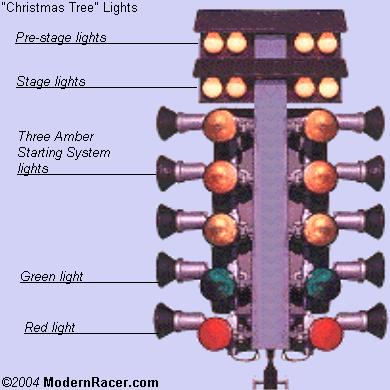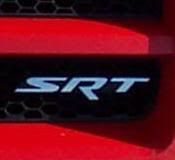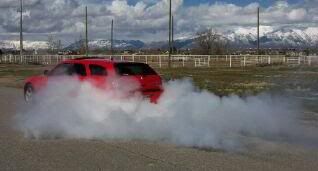Post by EddyRican on Mar 31, 2011 6:47:42 GMT -7
Keys to winning
1. You will win or lose at the tree
2. Consistency, not speed, wins
3. You won’t lose with a fast dial in
4. Luck plays a part
The Staging Lanes
The race really starts in the staging lanes. To develop consistency, you must develop consistent habits in the staging lanes. The biggest hobgoblin we LX’rs must contend with is heat. Therefore, you must strive to reach the head of the staging lane at a consistent temperature.
Coolant temperature is part of the equation, but not the whole story. You should run a low temp thermostat, 180 or 170 is fine, and you need to run both of your fans to get that temperature down between runs.
The next issue is the general underhood temperature. The hotter the engine compartment, the slower your run, but by how much? Don’t guess, just get the temperature under the hood down. Do the obvious, open the hood and leave it open. I open my hood as soon as practical after a run and leave it open until I am at the head of the staging lane.
Don’t run the engine unless you are moving the car. Idling raises the coolant temperature and the underhood temperature. I leave the EVIC on the screen that shows the coolant temp and the battery voltage. If the voltage is above 12V, the car will always start. Don’t worry about the battery. To further minimize moving the car, I always try to be the first car in the line or as least as close to the head of the line as I can.
From the Staging Lane to the Tree
Consistency and well formed habits are essential as you get ready to stage. You need a checklist to make sure you have done everything you planned to do. Is ESP off, in the right gear, helmet on, seat belts fastened, windows up, etc. Follow the same sequence every time so that you do not have to think about it. You need to focus on a launch and not these other details.
Here is some good information on burnouts and staging. Of course, I don’t do burnouts (can’t), but most of you will need to.
The burnout is key.
On street tires like an RSA's you want to spin them till smoke rolls off and NO waterbox on street tires.Set them about 24 psi if its on an 8.5" rim and 26-28 on a 9" rim.
With DR's I like to keep the pressure as high as possible until the car breaks traction.....in the warmer weather I run my DR's at 28lbs and down as low as 18 in the cold.A burnout just to clean the tire and slightly warm it is all thats required.
Use the converter......don't dumb launch(just mash the gas),especially if your making power.....that breaks parts.Stall the car against the converter(one foot on brake and one on the gas)and bring the rpm's up till the car wants to move.
When the lights come down the tree and you launch just lift off the brake and maintain the pedal position on the throttle.....this will let the car "hop" off the line and get a roll before you apply more throttle(this all happens in a nano second and is where the practice comes in).
Once the car is moving roll into the throttle smoothly and quickly.
Your throttle application will vary depending on track conditions.
Most of the guys you see with crazy 60' times do it like this.Just takes alot of practice so get to the track and have fun.
However, keep in mind that the above discussion is geared toward getting the best ET’s and not for the most consistent ET’s. You want consistency and not a banzai run every pass. I found that my launch RPM’s and techniques can either be optimized for ET’s or RT’s and you will likely find the same for your car also. Experiment during the test runs each time to find that sweet spot.
Even more important than consistent runs is your RT. It is the general consensus that a deep stage gives better RT’s than a shallow stage, but keep in mind that the difference is only a few inches. In bracket racing, RT is king. You will win or lose at the line and so will your opponent, perhaps on as much as 75% or more of your runs.
You need to develop a launch technique that gives the best and most consistent RT’s. So what is a good RT? " RT means Reaction Time" not Road & Track
 You won’t lose very often with an RT less than .10 and you won’t win much with a .50 or higher. Of course those .00x’s will almost always win if you don’t make any other mistakes. “Red Light and good night” as the saying goes.
You won’t lose very often with an RT less than .10 and you won’t win much with a .50 or higher. Of course those .00x’s will almost always win if you don’t make any other mistakes. “Red Light and good night” as the saying goes. 
Getting that low RT and not the Red Light takes practice, thought, concentration and focus. It ain’t easy, but can be done with tons of seat time/practice.
At the Tree
Before staging, I make sure I am aware of the dial in for my opponent. If he is faster, I just ignore him. If he is slower but less than .50, I still ignore him. The really slow guys are trickier and you could be running someone that is 3 or 4 seconds slower.
As I approach the staging lights, I try to forget or ignore everything but the lights. If possible, I prefer to stage last as that gives me less time to think before we go. I bring my RPM’s up on the first amber and go on the third. Doing this will allow you to get a great Reaction time without red lighting and the more consistent you are the further you will get.
Those really slow guys, yeah they can be tough. Often they are beginners and will be slow on the lights and unsure of their dial in’s. But there are always some at every track that run to win with a slow car and know how to get it done. So, I try to ignore them also and just use my regular technique. It just requires a lot of focus to wait for my first amber to bring the RPM’s up.
Probably this seems a bit complicated and it is until you have done it enough that it does not require thinking about it. However, keep in mind that your opponent has to do the same thing and you really only have be better on that run than he will be, unless you Red Light. But if he Red Lights, you win no matter what you or he does after that. You should still make the run at full tilt just to verify your dial in though.
Dial in’s, much ado about not much
Ok, you ran an xx.32, an xx.36, and an xx.40 in your test runs. What should you dial in? First thing to understand is that you are now splitting small, curly hairs, the time differences demonstrated are in HUNDRETHS of a second. The second thing is the objective is not hitting your dial on the nose, the objective is to not break out. If you didn’t get your opponent at the lights, you are not likely to make it up at the finish line. So don’t break out, leave that dishonor to your opponent.
First question to answer is what was the order?
Ascending order, DA is increasing or the time interval between runs was short and you didn’t get cooled down between runs.
Descending order, DA was decreasing or you had a good cool down time.
Mixed, your launch techniques changed or the time intervals varied.
I rarely have seen DA changes of several hundred feet during a session. A 150 ft change in DA is worth about .01 in time, slower or faster. By the way, a 15% change in humidity will have the same effect. So as the sun goes down, the DA will most likely decrease and the humidity will increase.
In my experience, the cool down time between runs is really the prime consideration. If you have a cool down of 40 minutes or more between runs, you will likely be at optimal temperature for that day. On the other side, 6 or 7 minutes between runs will likely slow you down in the range of .05 or so, compounding if you continue back to back runs, and decreasing as the cool down time increases.
So you need to compare the cool down interval between practice runs to see the affect on your car on that day. At my home track, I can usually get 6 or 7 test runs without trying hard. However, at some events, you can only get 2 runs, but you usually get a well cooled car between runs.
So how do we play the sample numbers above? First issue, how long until we run again? Look at the last run and the cool down time from the previous run. If you think the cool down time would let you match your best run or you know that you just launched poorly on the slower runs, assume you will do better. If you anticipate or get a much longer cool down than you have had before, your car will run faster so allow for it.
So the magic number is .05 faster than you best run or your last run, which ever is faster. Remember we are playing with hundredths of a second here so don’t try to cut it too close, seriously. Option 2 above is most typical so we would go with xx.27.
So you are thinking “I haven’t run that fast today”. You haven’t run that fast yet, but more importantly, you can’t win if you breakout, don’t take the chance. Now you are thinking “That 2 or 3 or 5 hundredths might be the difference in the race!” Not very likely! Remember, the other guy has to dial in and not break out too. He is going to be over by 2 or 3 or 5 or more also or he is going to breakout and you win.
So the difference in winning is back at the light. You run 5 hundredths over, he runs 3 or 4 hundredths over his time and the winner will be the guy with the better light. Think about this way. You run a .07 light and he runs a 1.1 light. Will he be 6 hundredths closer on his dial in? Not unless you make a big mistake. In reality, you only have to have a 2 hundredths better light, whether it was a .01 or a 2.24.
So you win and go to the next round. Review your winning run. If you were 4 or 5 hundredths over then you look at how much cool down you will have for the next race. In most cases, you can just leave it alone. However, if the cool down is going to be short, as is common in the last couple of rounds in the bracket, you could raise the dial in by 2 or 3 hundredths. If the cool down is going to be long, you can probably lower it 2 or 3. Don’t make big changes, they will bite you. Remember, the objective is to win the race, not to hit the number. Let the other guy make the mistakes.
There is one special situation that you will encounter. You have everything all planned and know you have the right dial in for the situation, you have a good spot in the lanes and you are pumped and ready. Then a Mustang or Camaro oils down the track and it takes an hour to clean the mess up. Think! You now have an hour more of cool down time than you expected and your car is going to be faster! Take advantage of that while everyone else is jaw jacking and drinking soda pop. Bump your dial in down by another 5 hundredths. Smile quietly when your opponent fails to change his/hers.
At the finish line
You feel like you have done everything right and the finish line is coming up. Do you just let it run out or do you back off. Remember, the objective is to win the race. You don’t need to set any records and there is little glory in just running the number.
Let it run out if you are trailing, the other guy may be breaking out. If you are leading and the other car is more than a second faster on the dial in, keep the pedal to the medal. If he fly’s by you at the finish, maybe he will break out. It happens a lot.
If the other car is slower or less than a second faster and you are leading by a car length or so, you have him beat. Let out of the gas. Don’t take the chance on a breakout. You want to cross the line first, but a foot or 50 feet is still a win. Think about this way. If the opponent is dialed in near your speed or is slower, he is not going to have a burst of speed in the last 100 feet. However, those cars that are really faster than you are still accelerating hard right to the finish. Make them break out.
If you backed off, compare your interval times to your other runs. Were you running faster or slower on the interval times. Slower? Adjust your dial in. Faster? Aren’t you glad you backed off and are now going to the next round?
Another situation you will encounter is the “sand bagger”. In my experience, these are slow older cars with very skilled drivers. They can hit their brakes and still run just over their number. Watch the other competitors run and see what they do at the finish line. So how do you beat a “sand bagger”, the same way you beat everybody else, blow him off at the starting line. If your light is better, he can’t make up for that at the finish.
Go for it
You can do everything very well and still lose or you can screw up and still win. You are racing another guy that can get lucky or screw up worse than you did. We can’t all be the fastest in our class, but all of us can run and win in bracket racing. Try it and get hooked. If you have any suggestions or questions post away. We can all learn how to be more consistent winners.
What the tree looks like

When you pull up at the line for staging, you can try your luck, or your skill, to stage as far into the staged beam as you can. How you stage has a large effect on things like your reaction time and final time.
Staging "shallow" means that your car takes more time to pass through the staged light and increases your reaction time, assuming all other variables are constant. However, it lowers your final elapsed time, and increases your trap speed. This is because the timer doesn't start the timer until the tire comes out of the starting line beam. By then, your car is already moving, so you get a slight running start. This only gives you an advantage over your opponent if you are a bit quicker in your reaction time to make up the difference. The thing is, the race is won based on who crosses the finish line first, not your elapsed time. It's possible to have a quicker time and still lose because you were late off the line. Shallow staging also allows for a driver who leaves early or creeps forward a bit before the green light.
"Deep" staging puts you at the edge of disqualification, but also a little closer to the finish line, which is always an advantage. If you find that you can't get your reaction time down enough, either because your car is a little jumpy off the line or you are having trouble leaving on that last yellow, deep staging can help. If you have large-diameter front tires, you probably want to deep stage to decrease your rollout. But be aware that if you car has very little ground clearance, pieces of the front bodywork or suspension can also trigger the lights. Be sure that it is really your tire in the staged beam, and not your front chin spoiler.
So in conclusion, shallow staging increases your reaction time, reduces your elapsed time and increases trap speed, while being the safe choice for beginners. Deep staging decreases your reaction time, increases elapsed time and reduces the final trap speed, putting you at the edge of disqualification so it should be reserved for experienced racers.
That should cover the basics of getting ready for your drag run without heavy modifications to your car. There are more things that people do, like put ice on the air intake and such, but those are touchy subjects. And launching the car is another subject by itself. Just have fun. For as little as $10, you can test your skills at a proper drag strip, while speeding to your heart's content and keeping your behind out of jail.






